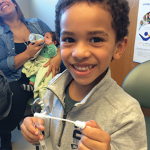There are still serious workforce shortages, Dr. Sandborg warned. Ten states in 2012 had no board-certified pediatric rheumatologists, and 40% of pediatric training programs do not have a pediatric rheumatology program, she noted. A number of states, especially in the West, are severely understaffed. “There are barriers that we are still continuing to address. The clinical burden still distracts from the research focus,” she said.
Research Collaboration
Pediatric rheumatology investigators needed an inclusive platform to collaborate on research studies and network, said Dr. Sandborg. After a summit meeting in 2000, a team of pediatric rheumatologists conceived the CARRA registry, basing it on a successful children’s cancer registry. Goals were not only to improve the academic standing of pediatric rheumatology, but “to improve outcomes and the quality of life for children with rheumatic diseases, and to drive funding,” said Dr. Sandborg.
CARRA’s guiding principles included a scientific agenda set by the members, not by drug companies or other bodies, she said. The research has to be of high scientific merit and translational, and there must be transparency, she noted. CARRA currently has 394 members at 107 institutions and is aided by funding from the Arthritis Foundation.
Four major CARRA clinical trials are now flourishing, Dr. Sandborg said. These include the APPLE trial, which looks at whether or not atorvastatin reduces carotid atherosclerosis in pediatric systemic lupus erythematosus, and the 12-month Trial of Early Aggressive Therapy, or TREAT, investigating 86 children with polyarticular JIA and funded by the NIH. Initial results of TREAT show that early, aggressive therapy resulted in clinically inactive disease in six months, and clinical remission on medication within 12 months, said Dr. Sandborg.
CARRA members are working on a comprehensive, nationwide patient registry, Dr. Sandborg said. “We wanted to create a platform to learn from every patient,” she said. Currently, the CARRA registry includes data on more than 9,000 patients at 60 sites, including 71% with JIA and 12% with juvenile systemic lupus erythematosus.
An important outcome of the registry is the creation of consensus treatment protocols for every major juvenile rheumatic disease. “The idea of creating these consensus treatment plans was, first, to publish so they entered the lexicon of people treating pediatric rheumatic diseases. Then, to create a platform of data so we can test what works and what doesn’t,” said Dr. Sandborg.
What about the future of pediatric rheumatology? CARRA’s current strategic plan includes creating a safety registry, developing innovative trial designs, more international collaborations with pediatric rheumatologists abroad, and more patient and family engagement, Dr. Sandborg said. Their goals are lofty, she added. “The cure is in there. We think we are ready to talk about cures.”
